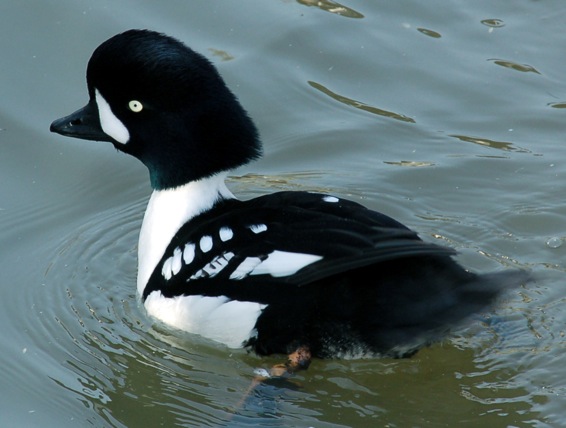|
Lake Myvatn:
Bird life
The
lake
is fed by nutrient-rich spring water and has a high abundance
of aquatic insects (Chironomidae and Cladocera) that form an attractive
food supply for ducks. Thirteen species of ducks nest here. The duck
species composition is unique in the mixture of Eurasian and North
American elements and of boreal and arctic species. Most of the ducks
are migratory, arriving in late April - early May from north-western
Europe. The most abundant is the Tufted Duck, which
immigrated to
Iceland at the end of the 19th century. The Greater Scaup is the second
most common duck species  Barrow's
Goldeneye is the
most characteristic bird on lake
Myvatn and river Laxa. This duck breeds in no other place in Europe.
The population, consisting of some
200 birds, is dependent on the ecological system of this lake
area.
Barrow's
Goldeneye is the
most characteristic bird on lake
Myvatn and river Laxa. This duck breeds in no other place in Europe.
The population, consisting of some
200 birds, is dependent on the ecological system of this lake
area. Barrow's Goldeneye is one of the few species in Iceland that originated in the western hemisphere. In the Rocky Mountains of North America, it nests in holes in trees, but at lake Myvatn, it nests in holes and crevices in the lava field. A considerable number of nests can also be found in sheep houses and barns, where nesting boxes have been provided for the birds. Most of the Barrow's Goldeneyes overwinter there, using ice-free areas kept open by emerging spring water (both warm and cold) and in the strong river current. The largest habitation of Slavonian Crebe in Iceland is in the Myvatn district, with more than 200 pairs nesting there on average. The bird builds floating nests in vegetation at the bank of the lake, most often under bushes that droop over the water or in duckweed. Two other species that can rarely be found in Iceland live in the area. These are the Common Scoter and Gadwall. The Common Scoter is a diving duck, and is most commonly seen on the west part of the lake. The males are easily recognizable due to their all-black colour. The Gadwall is a dabbing duck and is scattered all over the area. Harlequin Ducks can be found all over Iceland, but they are more common in Laxa than anywhere else. They live only on rivers during the summers and cannot be found on lake Myvatn. All species of Icelandic water birds, apart from Common Shelduck, nest in the Myvatn and Laxa area. The Tufted Duck is the most common, but Scaup, Wigeon, Teal and Red-breasted Merganser are also common. The Red-necked Phalarope is also very common. Whooper Swans and Greylag Geese are often seen, and a large flock of swans resides in the Myvatn area throughout the summer. Pink-footed geese nest in the highlands south of the lake, and to some extent by the lake. A few pairs of Great Northern Driver and Red-throated Driver nest in the Myvatnssveit district. Blackheaded Gull and Arctic Tern are common, and most species of waders, Passerines and birds of prey can be found in the area. Ptarmigans are particularly common, and several pairs of Gyrfalcon nest here, as well as some pairs of Short-eared Owl and Merlin. Other common species include the Red-breasted Merganser, Wigeon, Mallard, Long-tailed duck and Teal. The outflowing Laxa river has a dense colony of Harlequin Ducks and there is a large colony of Eiders at the river mouth some 50 km away from Lake Myvatn. The other duck species nest abundantly in the numerous islands of the lake and the surrounding marshlands. There is a long tradition of harvesting duck eggs for home use on the local farms. To ensure sustainability, the harvesting follows strict age-old rules of leaving at least four eggs in a nest for the duck to incubate. |